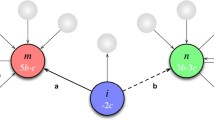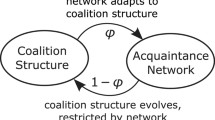Abstract
The evolution of internation relationships is studied by means of a mathematical model based on a popular rule of triadic interaction: “the friend of my friend is my friend, the friend of my enemy is my enemy, the enemy of my enemy is my friend, the enemy of my friend is my enemy”. The rule is shown to lead to the formation and preservation of unipolar and bipolar configurations of nations, with the strengths of relationships, both friendly and conflictual, intensifying through time. These results confirm speculations originally made in static, graph theoretic studies of the balancing of relationships within individuals, small groups and systems of nations.
Similar content being viewed by others
References
Ashley, Richard K.: 1980,The Political Economy of War and Peace: The Sino-Soviet-American Triangle and the Modern Security Problematique, Frances Pinter, London.
Cartwright, Dorwin and Frank Harary: 1956, ‘Structural Balance: A Generalization of Heider's Theory’,Psychological Review 63, 5, 277–93.
Cartwright, Dorwin and Frank Harary: 1960, ‘A Note on Freud's “Instincts and Their Vicissitudes”’,International Journal of Psychoanalysis 40, 287–90.
Flament, Claude: 1963,Applications of Graph Theory to Group Structure, Prentice-Hall, Englewood Cliffs: New Jersey.
Goldstein, Joshua S. and John R. Freeman: 1990,The Three-Way Street: Strategic Reciprocity in World Politics, University of Chicago Press, Chicago.
Grossmann, Siegfried and Gottfried Mayer-Kress: 1989, ‘Chaos in the International Arms Race’,Nature 337, 701–4.
Harary, Frank: 1959, ‘On the Measurement of Structural Balance’,Behavioral Science 2, 4, 316–23.
Harary, Frank: 1961, ‘A Structural Analysis of the Situation in the Middle East in 1956’,Journal of Conflict Resolution 5, 2, 167–78.
Hart, Jeffrey: 1974, ‘Symmetry and Polarization in the European International System, 1870–1879: A Methodological Study’,Journal of Peace Research XI, 3, 229–44.
Healy, Brian and Arthur Stein: 1973, ‘The Balance of Power in International History: Theory and Reality’,Journal of Conflict Resolution 17, 1, 33–61.
Heider, F.: 1946, ‘Attitudes and Cognitive Organizations’,Journal of Psychology 21, 107–12.
Kaplan, Morton A.: 1957,System and Process in International Politics, John Wiley and Sons, New York.
McDonald, H. Brooke and Richard Rosecrance: 1985, ‘Alliance and Structural Balance in the International System: A Reinterpretation’,Journal of Conflict Resolution 29, 1, 57–82.
Morissette, J. O.: 1958, ‘An Experimental Study of the Theory of Structural Balance’,Human Relations 11, 239–54.
Most, Benjamin A. and Harvey Starr: 1983, ‘Conceptualizing War’,Journal of Conflict Resolution 27, 137–60.
Most, Benjamin A. and Harvey Starr: 1989,Inquiry, Logic, and International Politics, University of South Carolina Press, Columbia.
Richardson, Lewis F.: 1960,Arms and Insecurity, Boxwood Press, Pittsburgh and Quadrangle Books, Chicago.
Schrodt, P. A.: 1978, ‘The RichardsonN-Nation Model and the Balance of Power’,American Journal of Political Science 22, 364–90.
Smith, Theresa Clair: 1980, ‘Arms Race Instability and War’,Journal of Conflict Resolution 24, 2, 253–84.
Waltz, Kenneth N.: 1964, ‘The Stability of a Bipolar World’,Daedalus 93, 881–909.
Waltz, Kenneth N.: 1979,Theory of International Politics, Addison-Wesley, Reading.
Ward, D. M.: 1984, ‘Differential Paths to Parity: A Study of the Contemporary Arms Race’,American Political Science Review 78, 297–317.
Wayman, Frank Whelon and T. Clifton Morgan: 1990, ‘Measuring Polarity in the International System’, in J. David Singer and Paul Diehl (eds.),Measuring the Correlates of War, University of Michigan Press, Ann Arbor, pp. 139–56.
Zinnes, D. A., J. V. Gillespie, and R. M. Rubison: 1976, ‘A Reinterpretation of the Richardson Arms Race Model’, in D. A. Zinnes and J. V. Gillespie (eds.),Mathematical Models in International Relations Research, Praeger, New York, pp. 189–217.
Author information
Authors and Affiliations
Additional information
This research was funded by a grant from the World Society Foundation, Zurich, Switzerland.
Rights and permissions
About this article
Cite this article
Lee, S.C., Muncaster, R.G. & Zinnes, D.A. ‘The friend of my enemy is my enemy’: Modeling triadic internation relationships. Synthese 100, 333–358 (1994). https://doi.org/10.1007/BF01063907
Issue Date:
DOI: https://doi.org/10.1007/BF01063907




